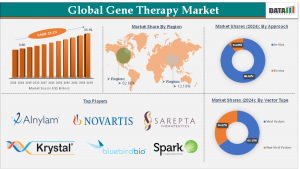Gene Therapy Market Fueled by CRISPR Advances & Regulatory Momentum | DataM Intelligence
Gene therapy market surges on breakthroughs in genome editing, rising chronic & genetic disease cases, regulatory approvals, and expanded manufacturing capacity
TEXAS, TX, UNITED STATES, July 31, 2025 /EINPresswire.com/ -- Gene therapy treatments using genetic material to correct or treat diseases is gaining traction, particularly in rare genetic disorders, oncology, and beyond. According to DataM Intelligence, the market size reached US$ 4.80 Billion in 2024 and is estimated to reach US$ 35.91 Billion by 2033, growing at a CAGR of 23.1% during the forecast period 2025-2033.Drivers include regulatory approvals (e.g. exa-cel, Zolgensma), increasing gene editing R&D, and significant pharmaceutical investment. Innovation in viral vector design, CRISPR platforms, and specialized CDMO capacity underpin this growth.
Download exclusive insights with our detailed sample report (Corporate Email ID gets priority access): https://www.datamintelligence.com/download-sample/gene-therapy-market
Gene Therapy Market Segments
By Vector Type:
Viral vectors account for over 65% of revenue in 2024, led by adeno-associated virus (AAV) and lentiviral systems. Non viral vectors are growing fastest due to safety and scalability advantages in newer gene-editing trials.
By Therapeutic Area:
Oncology is the fastest-growing segment, driven by CAR-T and gene-editing cancer therapies. Neurological and rare genetic conditions currently hold the largest share, with approved products like Zolgensma and exa-cel setting precedent and expanding adoption.
Key Players & Collaborations
Leading gene therapy developers include Novartis, Bluebird Bio, Spark Therapeutics (Roche), CRISPR Therapeutics (with Vertex), Sangamo Therapeutics, Orchard Therapeutics (Kyowa Kirin), Gilead/Kite, Biogen, Amgen, and BioMarin.
Notable innovations:
• CRISPR Therapeutics gained approval for exa cel (CTX001) in sickle cell disease and beta thalassemia in late 2023, advancing gene editing commercialization.
• Bluebird Bio’s Lyfgenia, FDA allowed outcomes-based pricing and expanded coverage agreements in U.S. Medicare contracts.
Regional Market Dynamics in Gene Therapy Market
• North America dominates thanks to advanced regulatory frameworks, insurance coverage for rare diseases, and concentration of biotech innovation hubs.
• Asia-Pacific led by China, Japan, and India is the fastest-growing region, powered by increasing genetic disease awareness, CDMO infrastructure expansion (e.g. Japan’s automated iPS cell manufacturing), and favorable government biotech programs.
• Europe is supported by advanced gene therapy approval pathways, collaborative research networks, and recent acquisitions, including BioNTech’s takeover of CureVac to build mRNA and RNA therapy platforms in Germany.
• Latin America, Middle East & Africa remain nascent, but growth is emerging via research partnerships and increasing access to rare disease treatments in Brazil, GCC countries, and South Africa.
Looking for in-depth insights? Grab the full report: https://www.datamintelligence.com/buy-now-page?report=gene-therapy-market
Recent Investments & Key Developments
United States
• June 2024: Sarepta’s DMD gene therapy Elevidys earned broader FDA approval for children ≥4 and non-ambulatory patients, elevating potential market coverage to ~90% of U.S. DMD cases and driving a ~33% spike in share price, despite growing FDA scrutiny.
Japan
• April 2025: Kyoto University’s CiRA began fully automated production of autologous iPS cells for regenerative and gene therapy applications, reducing cost barriers and speeding personalized therapy workflows.
Europe
• June 2025: Bluebird Bio agreed to be acquired by Carlyle Group and SK Capital in a bailout deal valued at up to USD 96 million, aimed at sustaining rare disease gene therapy R&D despite financial pressures.
Innovation & Trends
• CRISPR and ex vivo editing therapies are emerging as key growth paths; platforms from CRISPR Therapeutics and Precision BioSciences (using ARCUS technology) target disorders like sickle cell and muscular dystrophy.
• Enhanced vector design collaborations, notably Roche’s >USD 1 billion partnership with Dyno Therapeutics to develop next-generation AAV for neurologic conditions, are shaping safe and efficient delivery systems.
• Outcomes based contracting is taking hold, particularly with ultra-costly therapies like Lyfgenia, where payers only pay full price upon long-term benefit verification.
Challenges & Market Outlook
Challenges:
• Safety Concerns & Public Trust: Recent fatalities linked to Sarepta's Elevidys trials have raised investor and regulatory scrutiny, dampening sentiment despite scientific promise.
• Cost & Access: With therapies priced at USD 2–3 million per treatment, scaling access outside wealthy healthcare systems remains challenging.
• Investor Confidence: A steep pullback in gene therapy dealmaking and M&A over the past 18 months reflects reduced risk appetite and caution following technical setbacks.
Future Outlook:
Despite volatility, the pipeline of ex-vivo gene editing, oncology-targeted treatments, and safer viral vectors continues to grow. Stakeholders investing in scalable manufacturing, regional clinical trials (especially in Asia), and reimbursement innovation are best placed to lead global expansion toward a multi billion-dollar gene therapy market by 2033.
Unlock 360° Market Intelligence with 2 Days FREE Trial Access of DataM Subscription Now!: https://www.datamintelligence.com/reports-subscription
✅ Technology Roadmap Analysis
✅ Sustainability Impact Analysis
✅ KOL / Stakeholder Insights
✅ Pipeline Analysis For Drugs Discovery
✅ Positioning, Pricing & Market Access Snapshots
✅ Market Volatility & Emerging Risks Analysis
✅ Competitive Landscape
Have a look at our Subscription Dashboard: https://www.youtube.com/watch?v=x5oEiqEqTWg
Related Reports:
Glycomics and Glycobiology Market Overview
Cell Signaling Market Size
Sai Kumar
DataM Intelligence 4market Research LLP
+1 877-441-4866
sai.k@datamintelligence.com
Visit us on social media:
LinkedIn
X
Legal Disclaimer:
EIN Presswire provides this news content "as is" without warranty of any kind. We do not accept any responsibility or liability for the accuracy, content, images, videos, licenses, completeness, legality, or reliability of the information contained in this article. If you have any complaints or copyright issues related to this article, kindly contact the author above.
China Top Rooftop Air Handler Units Manufacturer Appearance In The 137th Canton Fair
Lactose Free Butter Market Current Trends and Future Scenarios 2019-2026
BPX Launches High-Speed Fit-Gap Analysis Framework Powered by Signavio
Więcej ważnych informacji
 Jedynka Newserii
Jedynka Newserii

 Jedynka Newserii
Jedynka Newserii

Konsument

Grupa nowych biednych emerytów stale się powiększa. Ich świadczenie jest znacznie poniżej minimalnej emerytury
Przybywa osób, które z powodu zbyt krótkiego czasu opłacania składek pobierają emeryturę niższą od minimalnej. Tak zwanych nowych biednych emerytów jest w Polsce ok. 430 tys., a zdecydowaną większość grupy stanowią kobiety – wskazują badania ekspertów Instytutu Pracy i Spraw Socjalnych. W ich przypadku krótszy okres składkowy zwykle wynika z konieczności opieki nad dziećmi lub innymi osobami w rodzinie. Wśród innych powodów, wymienianych zarówno przez panie, jak i panów, są także praca za granicą lub na czarno oraz zły stan zdrowia.
Media i PR
M. Wawrykiewicz (PO): Postępowanie z art. 7 przeciw Węgrom pokazało iluzoryczność tej sankcji. Unia wywiera naciski poprzez negocjacje nowego budżetu

Przykład Węgier pokazał, że procedura z artykułu 7 traktatu o UE o łamanie praworządności nie ma mocy prawnej z powodu braku większości, nie mówiąc o jednomyślności wśród pozostałych państw członkowskich. Negocjacje nowego budżetu UE to dobry pretekst do zmiany sposobu części finansowania z pominięciem rządu centralnego. Czerwcowy marsz Pride w Budapeszcie pokazał, że część społeczeństwa, głównie stolica, jest przeciwna rządom Viktora Orbána, ale i na prowincji świadomość konsekwencji działań Fideszu staje się coraz większa przed przyszłorocznymi wyborami.
Firma
Blockchain zmienia rynek pracy i edukacji. Poszukiwane są osoby posiadające wiedzę z różnych dziedzin

Zapotrzebowanie na specjalistów od technologii blockchain dynamicznie rośnie – nie tylko w obszarze IT, ale również w administracji, finansach czy logistyce. Coraz więcej uczelni wprowadza programy związane z rozproszonymi rejestrami, które wyposażają studentów w umiejętności odpowiadające wymogom rynku.
Partner serwisu
Szkolenia

Akademia Newserii
Akademia Newserii to projekt, w ramach którego najlepsi polscy dziennikarze biznesowi, giełdowi oraz lifestylowi, a także szkoleniowcy z wieloletnim doświadczeniem dzielą się swoją wiedzą nt. pracy z mediami.


![Nestlé w Polsce podsumowuje wpływ na krajową gospodarkę. Firma wygenerowała 0,6 proc. polskiego PKB [DEPESZA]](https://www.newseria.pl/files/1097841585/fabryka-nesquik_1,w_85,r_png,_small.png)






.gif)

 |
| |
| |
|